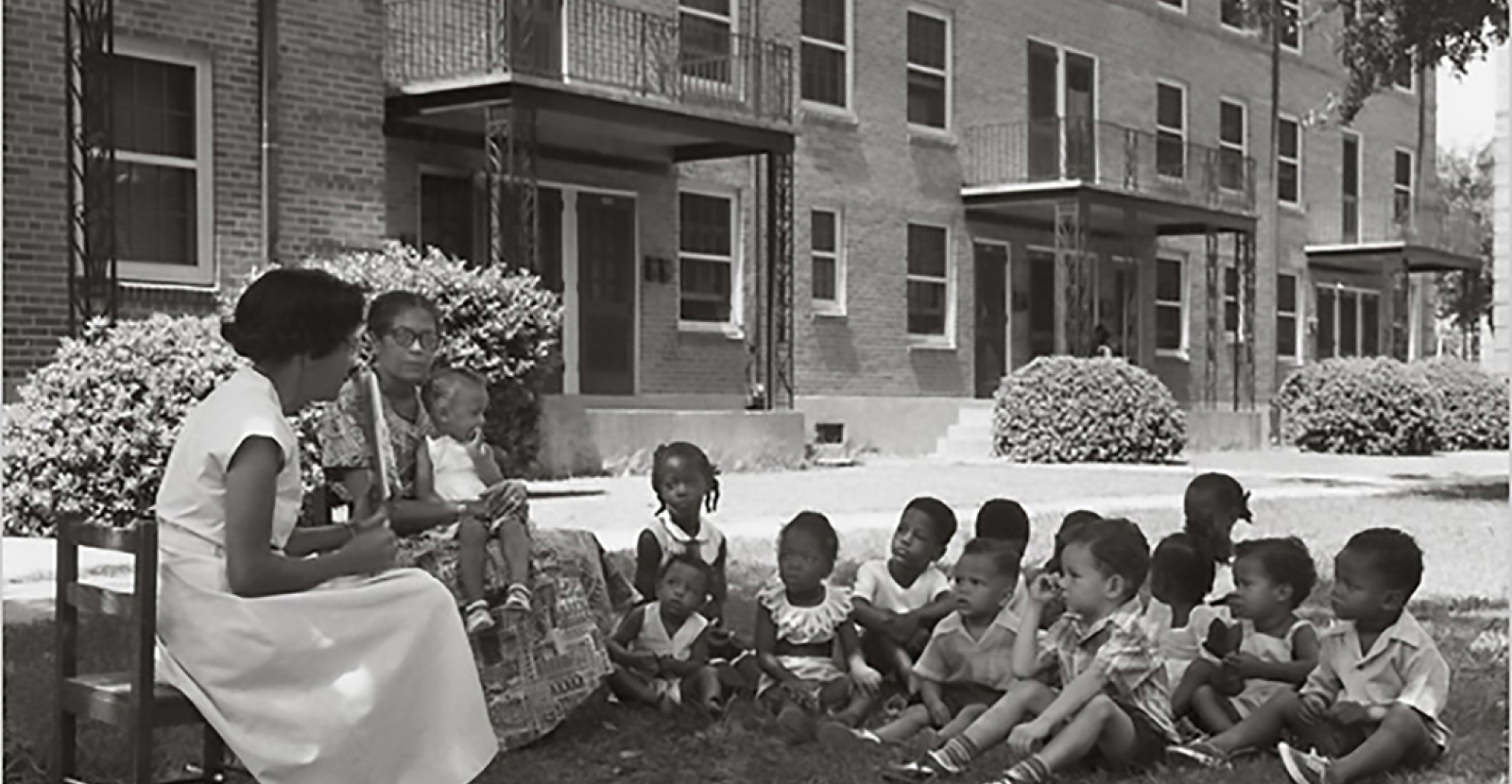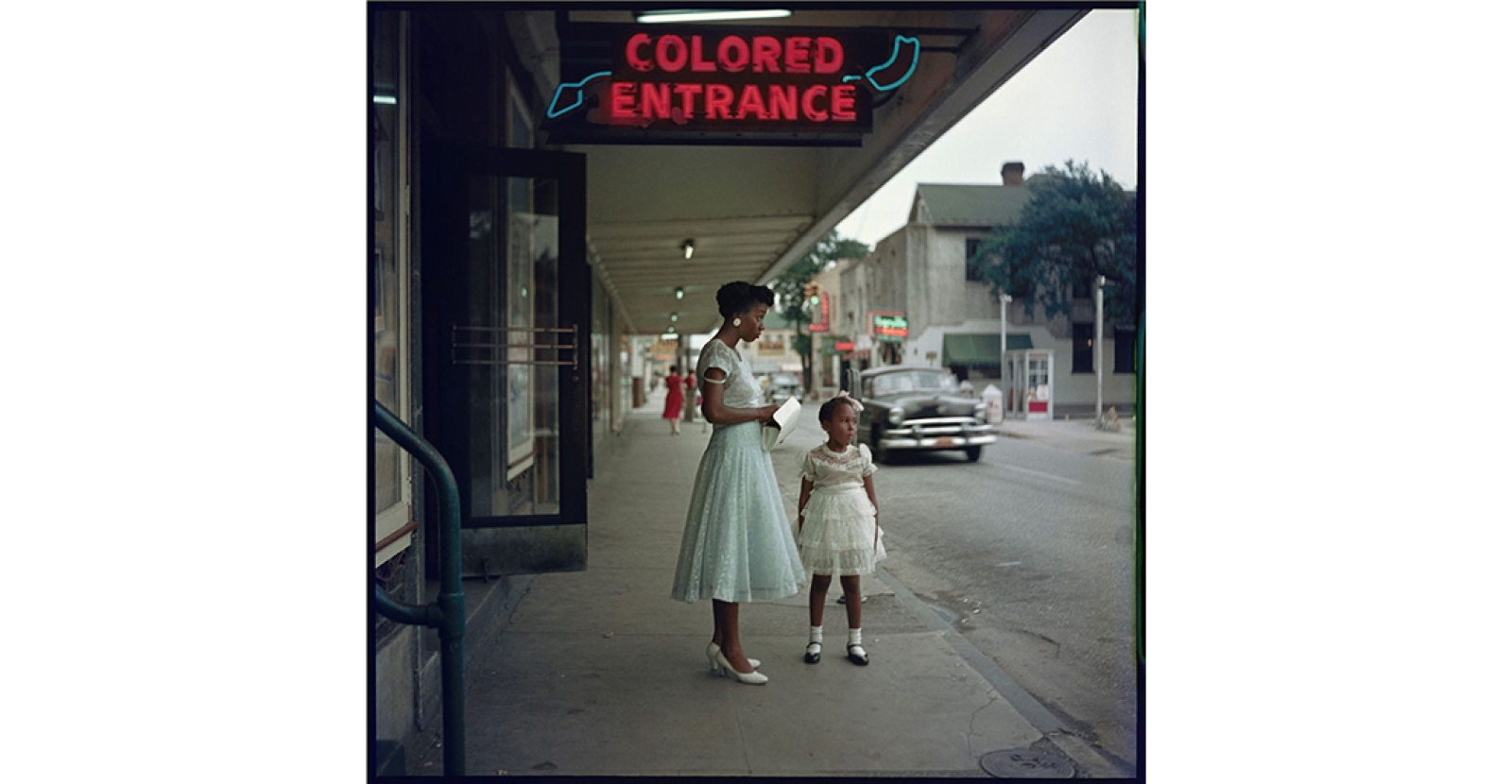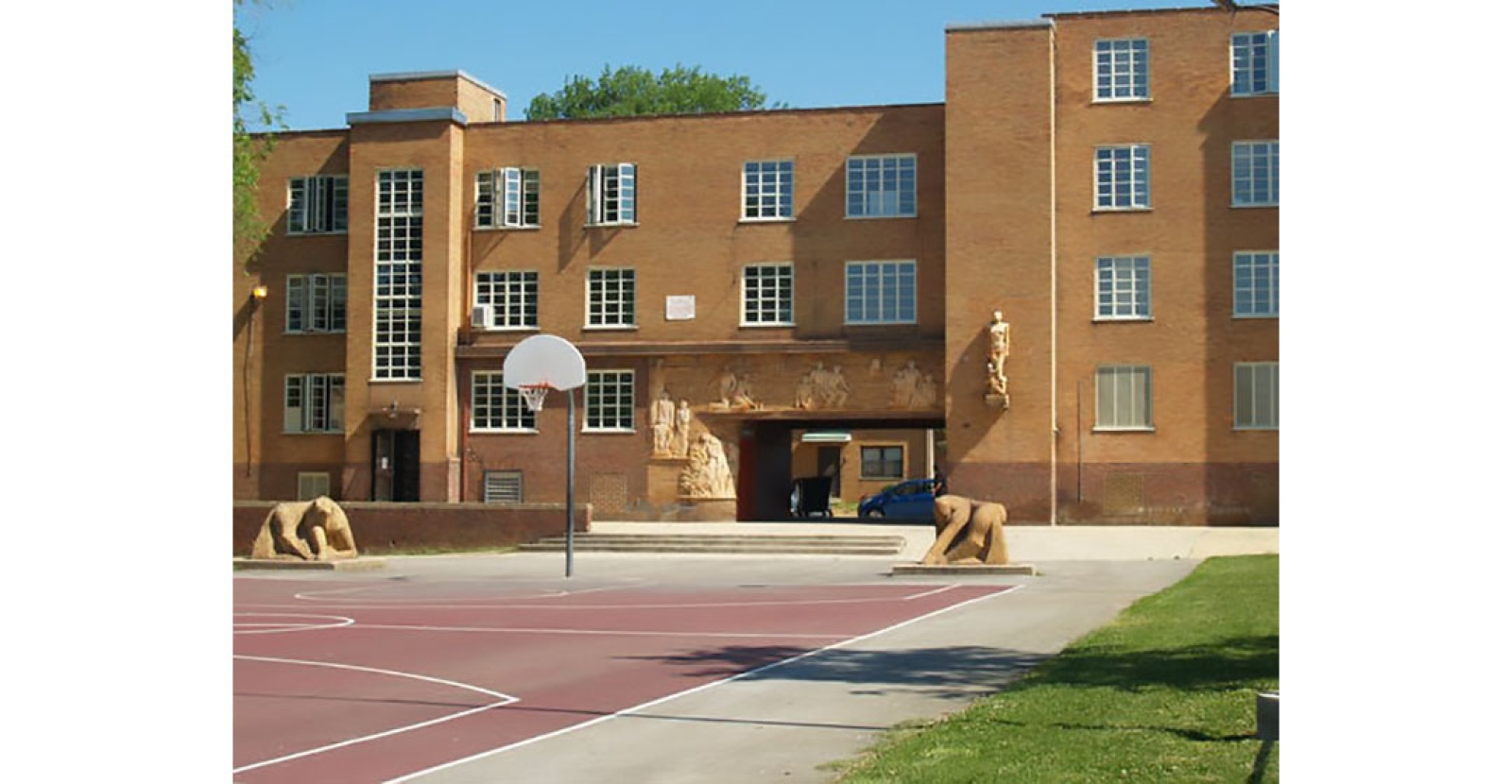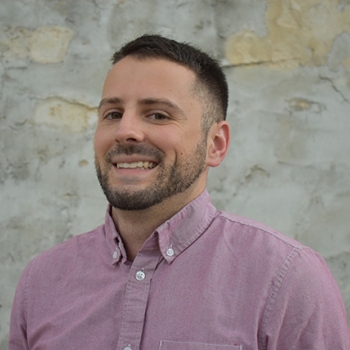Join our mailing list and receive invitations to our events and updates on our research in your inbox.
Against a Green Jim Crow
Injustice Made Material
"Trying to wash us away like we not on the map Wait, have you heard the latest They saying that you gotta have paper if you tryna come back…"
-Lil Wayne, ‘Georgia Bush’, 2006
When the levees failed on the morning of August 29, 2005 New Orleans’ New Deal-era public housing developments stood steadfast on their solid brick foundations. Le-Ann Williams reported to The Atlantic’s Vann Newkirk that she brought her family to shelter in her mom’s Lafitte apartment precisely because of their architecture. “The bricks”, Williams said, “not moving for a hurricane,” [sic] and she was right. The homes of 5,000 families would be destroyed not by wind or water, but by design.[1]
Built in 1941 by the Works Projects Administration (WPA), the Lafitte’s 896 units were designed by White architects Rosenthal, Kessels and Jones in a Modernist ‘garden city’ plan, and rented to Black families only in accordance with federal policy, according to Lolita V. Cherrie of New Orleans history blog Creolegen. The linear buildings’ syncopated front stoops echoed the blocks of Afro-Caribbean shotgun houses around them.[2] When they opened, residents were supported by WPA-financed nursery schools, on-site medical care and adult education programs, youth groups, and garden clubs.
Today the bricks are gone, replaced by privately managed, cheaply built stick-framed townhomes designed as lazy imitations of shotguns. The 517 units of the renamed ‘Faubourg’ (“Suburb”) Lafitte house far fewer people than the projects and at higher rents.
Hurricane Katrina and the federal flood did not destroy public housing in New Orleans. People in power did, perpetuating patterns established by the Jim Crow New Deal that built the projects. Like the COVID-19 pandemic, the purge of poor and working-class Black people from the city was what geographer Clyde Woods called an unnatural disaster, predetermined by generations of anti-Black, capitalist policy and practice.
Only through design, development, and administration centering the most marginalized can begin to heal these underlying conditions. A Green New Deal offers an opportunity for reparative democratic strategies, or, to repeat the same harmful authoritarian professional practices leading to ever-more-entrenched climate apartheid. This choice is not unique to New Orleans, but the layered traumas of COVID-19 today and the post-Katrina disaster 15 years ago broadcast the urgency of action from the banks of the Mississippi to the world.
300 years of racist urban development in New Orleans
Since settler colonization of Chitimacha, Choctaw, and Houma land in 1718, African-descended people have occupied the most environmentally precarious locations in the place we now call New Orleans. Behind the high-ground, wealthy, White riverside districts is the ‘backatown’, low-lying, swampy land where free and enslaved Black people developed their own neighborhoods.
The Treme, Third Ward, Seventh Ward, and Central City were renowned for their Black business districts and cultural institutions throughout the 19th and early 20th centuries. Beginning in the 1940s all faced the holocaust of urban renewal or, as James Baldwin called it, ‘Negro removal’ made possible by Jim Crow apartheid, the systematic removal of constitutionally guaranteed political power from Black Americans through laws and violent intimidation after the end of Reconstruction.
The development of the Civic Center, the I-10 Elevated, and Armstrong Park displaced thousands of Black families and hundreds of Black businesses. Civil Rights and Black Power activists brought new expectations for Black spatial self-determination to the Jim Crow landscape of New Orleans, organizing their own community-based, culturally centered design processes in an attempt to mitigate the disastrous effects of urban renewal projects as documented by urban planner Sara Zewde.
Second lines and block parties transformed the distance between buildings and the void beneath the bridge into necessary spaces of community life in a redlined neighborhood whose residents received a fraction of the federal funding their former White neighbors got in the segregated suburbs. As employers moved jobs from the city, project residents organized to demand respect and resources in a movement recorded by geographer, artist and activist Shana M. griffin. Though public housing was used to promote racist, sexist policies, it was a terrain Black women activists successfully contested, improving the conditions of their communities.
Neoliberal federal administrators sought to demolish public housing through the misleadingly named Housing Opportunities for People Everywhere program, or HOPE 6, begun in 1992. HOPE 6 was unpopular among public housing residents who knew its promise of “mixed income communities” meant their displacement, and feared a “right of return” would not be guaranteed. At River Garden, the privately managed complex that replaced the St. Thomas public housing development beginning in 2000, only 100 out of the 1,510 St. Thomas families were allowed to move back in. Residents of the Lafitte, Iberville, St. Bernard, Calliope and Magnolia projects organized to forestall their own dislocation.
The displacement of 16,000 public housing residents by the Katrina flood was an undemocratic pretext for continued demolition despite resident opposition while reports showed the structurally sound project buildings could be renovated for a fraction of the cost of replacement. Project buildings remained locked up with residents’ furniture inside. As advocate Judith Browne-Dianis explained, “It’s not about damaged units, it’s about whether low-income African Americans are welcome in New Orleans.”
The lost battle over New Orleans’ public housing in 2006-2007 weighs heavily on the city’s present, as an estimated 30,000 New Orleanians face the threat of eviction during a deadly pandemic.[3] The mass displacement of residents from neighborhoods adjacent to the old public housing sites for Airbnb short-term vacation rentals has been actively encouraged by a government that prioritizes the real-estate market over human lives.[4]
Neoliberal governance can’t solve these problems because it helped create them. In The Shock Doctrine: The Rise of Disaster Capitalism, journalist Naomi Klein explains how the privatization of public goods has made life worse for hundreds of thousands of poor and working-class people of all races who become more vulnerable to climate-change disasters as social services are cut. Disaster capitalism doesn’t work without racial capitalism, the use of racial categories to structure, legitimate and sustain the flow of capital theorized by political scientist Cedric Robinson through his study of the apartheid system of racial segregation in South Africa, itself influenced by American Jim Crow pioneered in New Orleans.[5]
The New Deal’s Jim Crow Politics
As we dream beyond neoliberal racial capitalism, we cannot look back to the era of big government liberalism with rose-colored glasses. To say the original New Deal was racist does not negate its vast positive impacts on the United States, or suggest a Green New Deal should not be attempted. It is to state a historical reality and the present fact that absent antiracist foundations, a Green New Deal will reinforce White supremacy and anti-Blackness just like its granddaddy.[6]
The racist compromises that passed signature New Deal legislation like the Emergency Relief Recovery Act of 1935, which created the WPA, and the Housing Act of 1937, which federally funded public housing, guaranteed that the benefits of these programs were administered in a racially segregated manner consistent with Jim Crow.
In The Color of Law: A Forgotten History of How Our Government Segregated America, Richard Rothstein explains how the Democratic coalition of Northern liberals and Southern conservatives negotiated the development of public housing on the condition of its segregation. Green New Deal advocate Daniel Aldana Cohen notes, “The New Deal didn’t just reproduce Jim Crow, it hardened it.”[7]
Black designers and a few White accomplices worked within the confines of the Jim Crow New Deal to effect antiracist interventions through architecture, planning, and policy. In Los Angeles, New York and Washington, DC, Black architects were hired by the WPA to design housing projects developed by the United States Housing Authority, as documented by Richard K. Dozier in ‘The Black Architectural Experience in America’.
Robert Robinson Taylor, the first African American to become a licensed architect, founded the Tuskegee architectural program in 1892. Architects like Tuskegee graduate John A. Lankford, University of Southern California graduate Paul Revere Williams, Columbia graduate Hilyard Robinson and Beverly Loraine Greene, a graduate of the University of Illinois and the first African American woman to be licensed as an architect in the US designed projects which demanded dignity and respect for the people who used them. Government work provided expanded opportunities for Black architects, and New Deal-funded projects offered commissions on a larger scale than ever before.
Two PWA-funded projects for Black tenants, Langston Terrace Dwellings in Washington, DC by Robinson, Paul Revere Williams and Black landscape architect David Augustus Williams, and the Harlem River Houses by New Orleans-raised John Louis Wilson, closely resemble the social housing of Red Vienna.[8] The public art-filled complexes designed in a streamlined Moderne style, planned around courtyards, also echo contemporary Jewish Socialist housing by Springsteen and Goldhammer in the Bronx.[9] Carefully detailed, human-scaled brick buildings embellished with playgrounds, plantings and public art, the projects represents a path of design dignity and respect not taken by most White architects of public housing for Black Americans.
Chicago Housing Authority (CHA) administrators Elizabeth Wood, a White woman, and Robert Robinson Taylor – son of Tuskegee’s Robert Rochon Taylor – used government power to racially integrate an all-White neighborhood. Wood and Taylor reserved units in the Trumbull Park Homes, a New Deal-funded PWA project on the Southwest Side, for Black residents. Politicians opposed these efforts and the CHA’s design and planning powers were used to contain African Americans in the South Side ‘Black Belt’. After Taylor’s death the CHA board gave his name to the world’s largest public housing project, sited to isolate 27,000 Black residents and designed with famously little regard for their humanity, in contradiction of everything he and Wood stood for.[10]
Segregation in public housing was prohibited by federal law in 1949. So began a wave of White flight in urban projects as residents able to obtain federally backed mortgages for suburban homes left. Conditions in urban public housing declined because cities and the federal government administered projects as warehouses for poor Black people whom they cut off from economic opportunities.
This was a feature, not a bug, of American public housing. The compromise negotiated by Catherine Bauer and the Housing Act’s authors with segregationist Senators and capitalist homebuilding interests required a 20 percent gap between the highest income allowed for public housing tenants and the lowest income at which the private sector provided decent housing.[11] Unlike in Vienna where publicly owned housing provided a permanent base for the poor and middle class, American public housing was intended as a temporary stop for the ‘worthy poor’ en route to their suburban single-family home. Black families, and Black women specifically, were not considered among the ‘worthy’ by lawmakers or administrators.
Social support programs and maintenance were cut. In the absence of needed resources, public housing residents organized through rent strikes, tenants’ associations, and groups like the National Welfare Rights Organization, which demanded adequate income, dignity, justice, and democratic participation.[12] Bottom-up methods, what we now call ‘community engagement’, entered the consciousness of White architecture and planning professions through the community design movement after 1968, when recognition of systematic anti-Black exclusion encouraged by the assassination of Martin Luther King, Jr. and Whitney Young’s now-famous speech compelled the American Institute of Architects (AIA) to respond by organizing regional urban design assistance teams (RUDATs) and supporting the formation of community design centers.
The more radical civil rights and Black Power citymaking of the Architects Renewal Committee (ARCH) in Harlem under the leadership of J. Max Bond and the Puerto Rican youth activist planning organization the Real Great Society (RGS) proposed truly democratized design and planning.[13][14] But the retreat from radicalism in the 1970s mostly ended such experiments, as Dr. Sharon Sutton chronicles in When Ivory Towers Were Black: A Story of Race in America’s Cities and Universities.
Black architects found opportunity in the Demonstration Cities and Metropolitan Development Act of 1964. Informally called Model Cities, this Great Society legislation was proposed as a corrective to the large-scale clearance and displacement caused by urban renewal that had dominated public housing development since the New Deal.[15]
These developments prototyped community development block grants (CDBGs), the post-public housing approach to urban development, in which local authorities distribute government funds to private and nonprofit developers who use it to build private subsidized housing. Disinvestment in public housing worsened as CDBG appropriations were cut, HOPE 6 demolitions progressed, and the 1999 Faircloth Amendment, prevented federal dollars from funding the construction of new public housing.[16]
Meanwhile, members of the New Urbanist movement supported HOPE 6 demolitions without replacement of units.[17] New York Times architecture critic Nicolai Ourossoff was one of the few national voices to see this injustice as it happened, but the best analysis he could articulate rooted public housing’s problems in “divisive racial politics”, rather than the reality of systemic racism.[18] Kanye West and Lil Wayne accurately called out the anti-Blackness at the heart of the federal government’s response to Katrina.
An Antiracist Green New Deal
Representative Alexandria Ocasio-Cortez’ Green New Deal for Public Housing proposes participatory planning processes that will pay residents for their work. The bill as written will remove the Faircloth Limits, and fund community-determined capital projects.[19] An antiracist Green New Deal for public housing will commission Black citymakers and other citymakers of color to develop and design projects in Black and White communities alike, meeting an iconic demand of New Orleans anti-demolition protestors who marched in the wealthy White Uptown neighborhood with the request, “Make This Neighborhood Mixed Income”.
Urban designer Atianna Cordova of Water Block, landscape architect Aron Chang, architect Bryan Lee, Jr, organizer Sue Mobley and urban planner Dasjon Jordan of Roux Collaborative exemplify, through their unique practices, different theories of change applied to design, planning and policy in the service of social justice. Each practitioner proposes profoundly democratized citymaking. In Jordan’s words, “the most important city planning questions are: Are we taking the time to observe and listen to the challenges communities are facing? …The people most affected by an issue have a better understanding of how to solve it; they sometimes just need our partnership to fix it.”
An antiracist Green New Deal is just a phrase without active democratization of the design and planning processes in the tradition of Black Power citymakers like the Real Great Society and the Claiborne Avenue Design Team. An antiracist Green New Deal cannot be implemented by a design profession that is upwards of 92% White and 2% Black, when less than 0.5% of architects and landscape architects are Black women. An antiracist Green New Deal is meaningless if it ignores the demands of activists like the youth leaders of BYP 100, including reparative polices to address the legacy of enslavement and Jim Crow, a focus on the wealth and health of trans people and divestment from policing and incarceration.
An antiracist Green New Deal for public housing will put this generation’s Beverly Greenes and Hilyard Robinsons to work facilitating spatial self-determination for Black Americans and others rendered vulnerable to the effects of climate change by racial-capitalist policy and practice. In New Orleans, Mobley and Lee’s Paper Monuments project democratized public art and public history planning, engaging 1,200 residents and hundreds of kids in the process of imagining new monuments for the city after the removal of four Jim Crow idols in 2017.[20]
Cordova’s Water Block Kids program builds the pipeline for demographic change by educating elementary-school students on design professional paths, and centers kids in neighborhood resilience planning through arts-based engagement strategies. St. Louis graphic designer Antoinette Carroll’s Creative Reaction Lab prepares Black and Latinx kids as leaders of efforts to design healthy and racially equitable communities. Such work sets the standard for community-based design and the Black women who lead it should be paid accordingly.
New Orleans’ New Deal public housing developments were precarious, imperfect, and necessary homes for their residents. The projects and the people who lived in them were always under attack by the racialized disaster capitalist authoritarian design, planning, and policies which ultimately destroyed them. These harms are layered atop each other. The Green New Deal must address the environmental precarity of oppressed communities through democratized, antiracist citymaking. One hurt can’t be healed without healing the other.
Rapper and activist Jasiri X identifies a lineage from post-Katrina protests, to organizing in support of the Jena Six, to the emergence of the Black Lives Matter movement after the acquittal of Trayvon Martin’s murderer. In the weeks after Martin’s murder, architect and educator V. Mitch McEwen wrote, “Somehow what we thought was just banal has been exposed as lawless. What we thought was merely cheap and boring has been revealed to be a recipe for inhumanity. But… if we take this on the way we have taken on climate change, stormwater run-off, or any other host of problems that once seemed outside our field, I know we can contribute to making this better.”
More work and writing by Chris Daemmrich can be seen at: rchrisdaemmrich.com and collabdesignworkshop.com
[1] https://www.nola.com/news/article_833cc3f5-2d6d-5edc-bc0f-ecd55ead7026.html
[2] https://www.datacenterresearch.org/pre-katrina/tertiary/shotgun.html
[3] https://www.nytimes.com/2020/08/09/opinion/evictions-foreclosures-covid-economy.html
[4] https://thelensnola.org/2020/07/28/a-major-paradigm-shift-new-orleans-hires-former-short-term-rental-executive-to-lead-land-use-regulation-with-new-business-minded-approach/
[5] https://www.sc.edu/uscpress/books/2001/3409.html
[6] https://jacobinmag.com/2019/08/new-deal-segregation-richard-rothstein-walker-color-of-law
[7] https://jacobinmag.com/2019/02/green-new-deal-housing-ocasio-cortez-climate
[8] https://www.nytimes.com/1989/11/04/obituaries/john-l-wilson-jr-91-architect-of-harlem-river-houses-is-dead.html
[9] http://s-media.nyc.gov/agencies/lpc/lp/1795.pdf
[10] https://www.blackpast.org/african-american-history/robert-taylor-homes-chicago-illinois-1959-2005/
[11] https://placesjournal.org/article/catherine-bauer-and-the-need-for-public-housing/
[12] https://www.blackpast.org/african-american-history/national-welfare-rights-organization-1966-1975/
[13] https://www.hup.harvard.edu/catalog.php?isbn=9780674971509
[14] https://www.plannersnetwork.org/1999/03/the-east-harlem-real-great-society-a-puerto-rican-chapter-in-the-fight-for-self-determination/
[15] https://urbanomnibus.net/2016/10/model-cities-redux/
[16] https://archinect.com/news/article/150173041/why-is-it-illegal-to-expand-public-housing-in-the-united-states
[17] https://landscapearchitecturemagazine.org/2017/02/16/new-urbanism-new-hud/
[18] https://www.nytimes.com/2006/11/19/weekinreview/19ouroussoff.html
[19] https://ocasio-cortez.house.gov/gnd/public-housing#:~:text=Representative%20Ocasio%2DCortez%20introduced%20the,quality%20of%20life%20for%20all.
[20] https://nextcity.org/daily/entry/with-paper-monuments-new-orleanians-draft-the-citys-history-themselves














